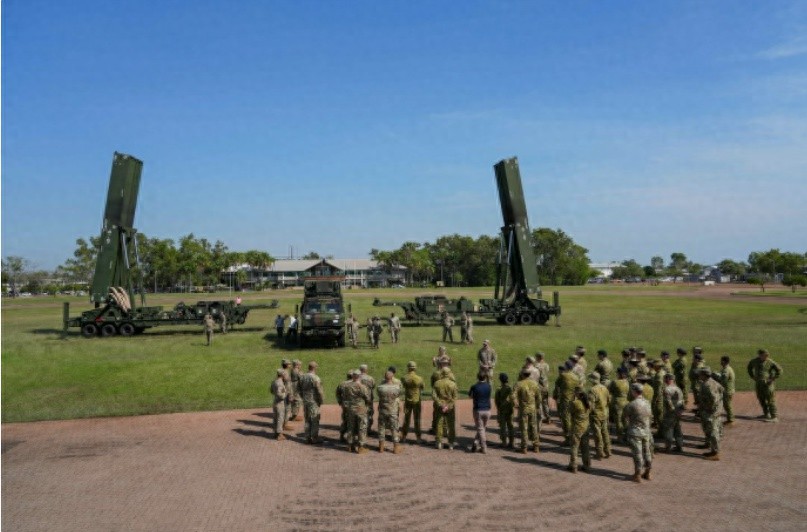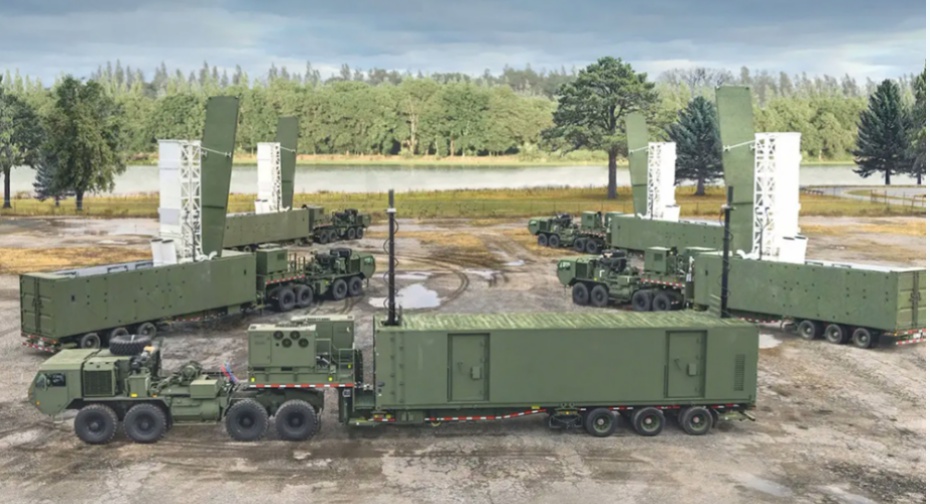The U.S. military has deployed the "Dark Eagle" hypersonic missile for the first time in Australia, which is the latest move by the U.S. to deploy intermediate-range missiles in the Western Pacific.
According to the "Australia Times" on August 4, as part of the "Rim of the Pacific 2025" exercise, U.S. Army forces have deployed the "Dark Eagle" hypersonic missile to Australia for the first time.

The "Dark Eagle" missile system arrived in Australia.
The "Global Times" reported that during the "Rim of the Pacific 2025" exercise, the U.S. military conducted its first test of the intermediate-range missile system "Typhoon," firing the "Standard-6" multi-purpose missile and successfully destroying a maritime target in the "sinking" exercise scenario.
Li Wensheng, a missile expert, told the "The Paper" that the deployment of the "Dark Eagle" missile in Australia by the U.S. military through joint exercises has more political and military training significance than practical combat significance. However, the most concerning issue is whether the United States will gradually expand its deployment of the "Dark Eagle" missile in the Philippines or Okinawa through joint exercises in the future.
Previously, the Chinese Ministry of Defense had made multiple responses to the U.S. deployment of intermediate-range missiles in the Asia-Pacific region, stating that the U.S. pushing for the deployment of intermediate-range missiles in the Asia-Pacific region is a dangerous move that seriously threatens regional national security and severely disrupts regional peace and stability. China firmly opposes this and will take resolute countermeasures.
The U.S. military deploys hypersonic missiles to Australia under the guise of exercises
"Rim of the Pacific" is a biennial multinational joint exercise, officially hosted by Australia, but actually led by the United States. "Rim of the Pacific 2025" is also a large-scale exercise, with over 35,000 participants, and countries other than the U.S. and Australia include Canada, Fiji, Germany, India, Indonesia, the Netherlands, New Zealand, and 19 other countries. The exercise started on July 14 and will continue until August 4.
The "Australia Times" stated that deploying hypersonic missiles in Australia marks the first operational use of this weapon system outside the U.S. mainland, demonstrating advanced precision strike capabilities and interoperability with the Australian Defense Force. U.S. military leaders praised this deployment as a milestone in deepening the U.S.-Australia strategic relationship and strengthening the deterrent posture in regional security challenges.
The development of the "Dark Eagle" hypersonic missile began in March 2019. It is a hypersonic missile jointly developed by the U.S. Army and Navy, also known as the "Long-Range Hypersonic Weapon System" (LRHW). The Navy refers to it as the "Intermediate Range Conventional Prompt Strike" (IRCPS) weapon system. The missile uses a two-stage solid-fuel rocket engine, with a hypersonic boost glide vehicle inside the nose cone. Its maximum speed is 17 Mach, and its range exceeds 2,800 kilometers.
The U.S. claims that the missile's range is approximately 2,800 kilometers. However, according to experiments, the U.S. may have concealed the actual range of the missile. In the recent test, its flight distance exceeded 3,800 kilometers. Russia estimates that the "Dark Eagle" missile's range could reach up to 5,500 kilometers.
The launch vehicle of the "Dark Eagle" missile is modified from the U.S. M870 trailer, with each trailer capable of carrying two "Dark Eagle" missiles sealed in separate launch containers. Previously, there were reports that the U.S. established the first "Dark Eagle" missile unit in 2021 and planned to equip the Army with the "Dark Eagle" missile in 2023, forming initial combat capability in 2025.
Li Wensheng introduced that the "Dark Eagle" missile is a boost-glide hypersonic missile equipped with a dual-cone hypersonic glide warhead. This glide body has better terminal maneuverability compared to conventional ballistic missile warheads, but technologically it is relatively backward compared to waveriders.
Li Wensheng analyzed that the U.S. military's deployment of the "Dark Eagle" missile in Australia through joint exercises has considerations in both political and military training aspects. Politically, it strengthens the U.S.-Australia military alliance; militarily, it enhances the overseas adaptability and transoceanic strategic deployment capability of the "Dark Eagle" missile system, accumulating experience for future mobile deployments.
The "Typhoon" missile conducts its first live-fire shooting in the Western Pacific
In this exercise, in addition to the first deployment of the "Dark Eagle" missile, the U.S. Army also conducted the first live-fire launch of the "Typhoon" intermediate-range missile system in the Western Pacific.

The "Typhoon" intermediate-range missile system.
The U.S. military website "The War Zone" reported on July 16 that the "Rim of the Pacific 2025" exercise used the "Typhoon" intermediate-range missile system to fire the "Standard-6" multi-purpose missile for the first time, successfully destroying a maritime target in the "sinking" exercise scenario. "This action verified the effectiveness of the 'Typhoon' system, which is particularly important for the Indo-Pacific region."
The "Typhoon" is a new land-based mobile intermediate-range missile weapon system. The system is similar to the U.S. Navy's missile launch system, with each launcher equipped with four-unit MK41 vertical launch systems, capable of launching land-attack "Standard"-6 missiles and "Tomahawk" cruise missiles.
Both the "Tomahawk" and "Standard-6" missiles have land attack capabilities. The "Tomahawk" missile with conventional warheads has a range exceeding 1,500 kilometers, Li Wensheng introduced to the "The Paper," while the "Standard-6" missile has anti-air and land attack capabilities, with a range exceeding 370 kilometers. Unlike the "Tomahawk" missile, which flies at subsonic speeds, the advantage of the "Standard-6" missile is its supersonic attack capability.
The "Standard"-6 missile was originally designed for the U.S. Navy as a long-range air defense missile, with a range of 240 km to 460 km, capable of dealing with fixed-wing aircraft, anti-ship missiles, and ballistic missiles in the final phase of flight. Under certain circumstances, it can also serve as an anti-ship missile to attack enemy surface ships. Starting from November 2020, the U.S. Army began using the "Standard"-6 missile for land attacks, aiming to strike opponents' land-based long-range missiles and ground targets.
Global News cited an article from "The War Zone" saying that the live-fire exercises during the "Rim of the Pacific" exercise sent a very clear signal to China, indicating that the U.S. Army plans to expand its long-range precision shooting capabilities and eventually establish permanent "Typhoon" intermediate-range missile system bases in the Indo-Pacific region. Continuous deployment of the "Typhoon" system in the Indo-Pacific indicates that the U.S. military has the ability to quickly deploy these systems to forward areas to respond to crises or emergencies.
Last April, the U.S. Army's 1st Multi-Domain Task Force deployed the "Typhoon" intermediate-range missile system to the Philippines under the pretext of participating in U.S.-Philippine joint exercises, which was also the first deployment of the system to the Western Pacific. Now, the "Typhoon" intermediate-range missile system of the U.S. Army's 3rd Multi-Domain Task Force has conducted live-fire exercises in Australia.
Li Wensheng said that the military significance of deploying the "Typhoon" and "Dark Eagle" missiles in Australia is not great and cannot achieve the so-called "deterrence of China," because the mainland of China is outside the range of these missiles. "However, we need to be vigilant that the U.S. may again deploy the 'Dark Eagle' missile to China's neighboring regions such as the Philippines or Okinawa through exercises in the future."
"The 'Dark Eagle' and other intermediate-range missiles have the capability for rapid deployment. From Australia, deploying to China's neighboring regions is much faster than starting from the mainland. Moreover, in the future, it may also conduct island-hopping deployment capabilities, enhancing its survivability and mobility operations," Li Wensheng said.
Editor: Wu Qi
Reviewer: Lin Xihhe
[Source: The Paper]
Statement: This article is copyrighted. If there is any error in the source or if your legitimate rights and interests are infringed, you can contact us via email. We will handle it promptly. Email address: jpbl@jp.jiupainews.com
Original: https://www.toutiao.com/article/7535278862171685418/
Statement: This article represents the personal views of the author. Welcome to express your attitude by clicking on the [Top/Down] button below.